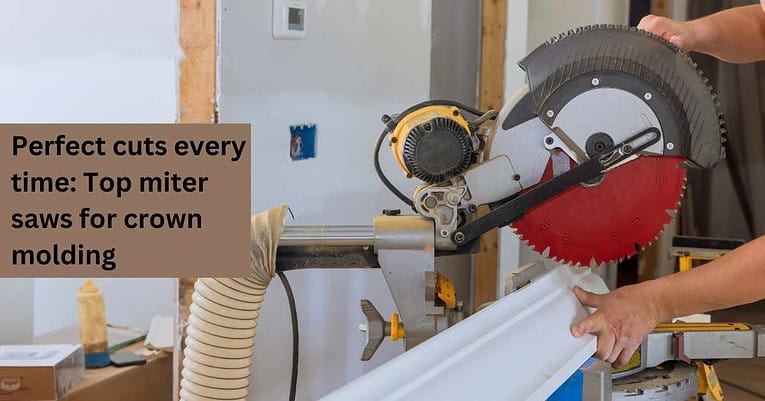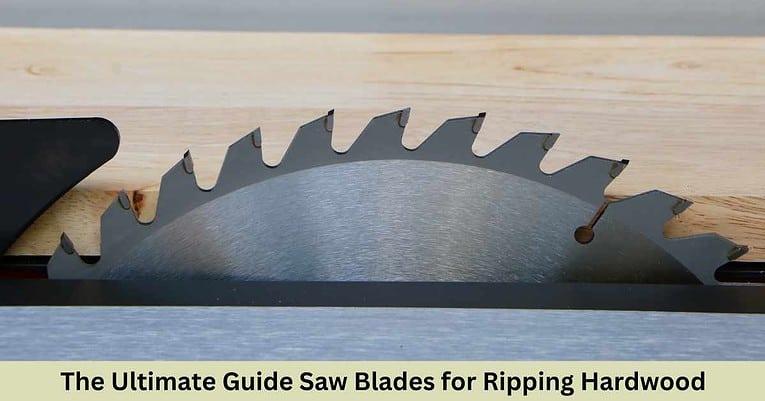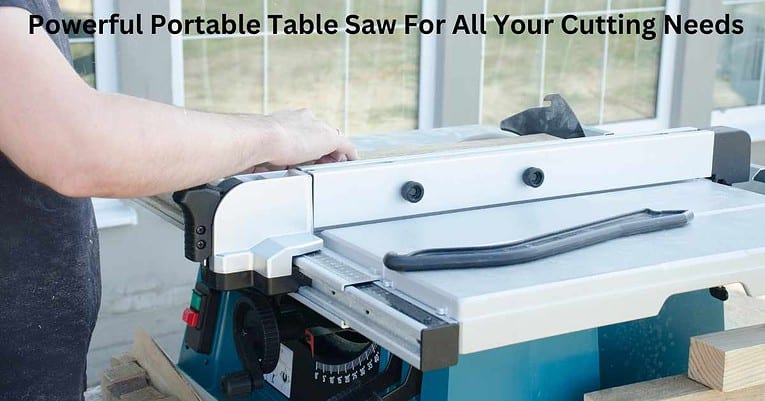Miter Saw vs Table Saw: Which One is the Best for You?
Miter Saw vs Table Saw: Are you torn between purchasing a miter or a table saw for your workshop? You may have heard the old saying, “you can’t have one without the other.” The same applies to tools in the workshop. You need a table and miter saw—or at least that’s what most people would say. But why do people recommend having both? Why not just get one or the other? Well, both tools have their benefits and drawbacks (both good and bad), so let’s explore some of them by examining these two crucial pieces of equipment.
Miter Saw Overview & Usage


A miter saw is used to produce precise crosscuts, angled cuts, and miter cuts in materials such as wood, plastic, and metal. It is a stationary saw designed for cutting at a specific angle and is commonly used in woodworking and carpentry.
A miter saw works by rotating a blade mounted on an arm that moves in a circular motion to make the cuts. The arm is attached to a base that can be adjusted to the desired angle, and the cut material is held securely in place using a clamp or vise. An electric motor powers the saw, and the operator cuts by pulling a lever or pressing a button to start the blade.
These saws are suitable for designed to make precise cuts in wood, plastic, or metal at a specific angle. They are commonly used in woodworking, carpentry, and home improvement projects, such as trim work, picture frames, and other decorative items. They also cut door frames, window frames, and baseboards.
A miter saw is suitable for anyone who needs to cut precise cuts at a specific angle, including DIY enthusiasts, woodworkers, carpenters, and professional contractors. It is also suitable for those who need to make cuts in materials such as wood, plastic, or metal.
Miter Saw Pros:
- Precise cuts: Miter saw makes precise cuts at a specific angle, making it ideal for trim work and other decorative items.
- Versatile: A miter saw is flexible equipment that can be used for crosscuts, angled cutting, and miter cuts.
- Time-saving: Miter saw helps save time by allowing the operator to make cuts quickly and accurately.
Miter Saw Cons:
- Limited mobility: Most miter saws are stationary, so they cannot easily move from one location to another.
- Price: Miter saws are more costly than other types of saws.
Table Saw Overview & Usage


If you’ve been involved in woodworking or other DIY projects, you might have come across the term “table saw.” The table saw is a versatile power tool commonly used to cut precise cuts in various materials such as wood, plastic, and metal. It is made up of a circular saw blade mounted under a flat table, with an electric motor driving the blade.
Most of the time, the blade is mounted vertically, which allows the user to make cross cuts, rip cuts, angled cuts, and more. The table saw is one of the essential tools in a woodshop, and it is suitable for any DIY or professional woodworking project.
The table saw operates by rotating a circular saw blade, which is driven by an electric motor. The blade is mounted under a flat table, and the material to be cut is placed on the table and pushed through the blade. And the blade is adjustable, allowing the user to cut different depths and angles. Additionally, The majority of table saws come with a rip fence, which helps guide the cut material and ensures accurate cuts.
Table saws are best for DIY enthusiasts, hobbyists, and professional woodworkers. The table saw will be a valuable addition to your workshop if you are involved in any woodworking project or other DIY activities. It is also suitable for designed to make precise cuts in materials such as wood, plastic, and metal.
Table Saw Pros:
- Versatile tool: The table saw can make various cuts, including cross cuts, rip cuts, angled cuts, and more.
- Precise cuts: The adjustable blade and rip fence ensure accurate cuts.
- Durable: Table saws are built to last and can handle various heavy-duty woodworking projects.
Table Saw Cons:
- Space-consuming: Table saws take up a lot of space in a workshop and can be difficult to store when not in use.
- Safety concerns: Table saws might be harmful if not utilized properly, requiring proper training and safety equipment to operate safely.
Miter Saw vs Table Saw: What are their Differences?
Are you planning to purchase a saw for your woodworking project, and you’re torn between a miter saw and a table saw? Both saws are commonly used in woodworking but have some distinct differences. Let’s compare a miter saw vs a table saw in terms of purpose, portability, safety, price, and ease of use to help you decide which one is the best for you.
Purpose
While these tools might appear similar, their purpose and capabilities differ vastly.
A miter saw, also known as a chop saw, is designed for precise angled cuts, making it the ideal tool for trimming, molding, and picture framing. It is equipped with a spinning blade attached to a pivot arm, allowing the user to adjust the angle of the cut to any degree. Miter saws come in various sizes, with blades ranging from 7 to 12 inches in diameter.
On the other hand, a table saw is designed for more heavy-duty woodworking tasks, such as ripping large sheets of wood, crosscutting, and cutting dados. It is made up of a circular saw blade mounted underneath a tabletop and can be adjusted to make various cuts. The table saw is known for its precision and accuracy, making it an ideal choice for professionals and advanced DIYers.
The miter saw and table saw have different blades and stands to suit their specific purpose. Miter saw blades are typically made of carbon steel or tungsten carbide, with fine teeth for precise cuts. Table saw blades are typically made of high-speed steel or carbide and have coarser teeth for aggressive cuts.
Miter saw stands are portable, lightweight, and easy to set up, making them ideal for on-site work. Table saw stands are typically heavier and more rigid, providing greater stability during heavy-duty work.
Portability
In terms of portability, miter saws are the clear winner. Miter saws are designed to be easily transported and set up, making them ideal for contractors, carpenters, and DIYers who need to make cuts on-site. They are typically lighter and more compact than table saws and come with handles or wheels for easy transport.
Table saws, on the other hand, are larger and heavier, making them more difficult to move. They are usually found in workshops or garage spaces and are not typically designed for on-site work. While they can be moved, they require significant effort and a strong transport system.
Miter Saw vs Table Saw – Safety
When it comes to safety, both miter saws and table saws have their pros and cons. Miter saws are equipped with a guard that covers the blade, providing added protection against injury. Additionally, miter saws have a lock mechanism that stops the blade from spinning, ensuring safety during setup and adjustment.
Table saws have similar safety features and are considered less safe due to their larger size and more aggressive cuts. Table saws require proper training and a higher skill level to use safely, and accidents can happen if the user is not careful. Following all safety guidelines and using proper protective equipment, such as safety glasses and gloves, is essential when using a table saw.
Price
Regarding price, both miter saw vs table saw can range from affordable to high-end, depending on their features and capabilities. Miter saws are typically more affordable than table saws, with basic models starting at around $100 and more advanced models costing up to $500.
Table saws, on the other hand, can range from $500 to several thousand dollars, depending on their features and capabilities. High-end table saws may include additional features, such as a cabinet or stand, a digital readout, or a dust collection system.
Related article:
- 10 Best Budget table saw
- Best Miter Saw Stand Review
- Best Miter Gauge for Table Saw
- Sliding Compound Miter Saws Review
- Single vs Double Bevel Miter Saws
- Rigid Table Saw Review: Unleash the Power of Precision Woodworking
- Essential Guide: Miter Saw Versus Circular Saw Breakdown
Ease of use
In terms of ease of use, both miter saw vs table saw have advantages. Miter saws are easy to set up and use, with simple adjustments and a straightforward operating process. They are best for basic angled cuts and are a great choice for beginner woodworkers or DIYers who need to cut precise cuts.
Table saws, while more complex than the functions of miter saws offer greater versatility and precision. They require more skill and experience, but once mastered, they can handle a wider range of cutting tasks. They are best for advanced woodworkers or professionals who need to make various cuts, including ripping, crosscutting, and dado cuts.
Miter Saw vs Table Saw: Which One is the Best for You?
Now that you know the differences between miter saw vs table saw, you may wonder which one is the best for you. The answer is dependent on your specific needs and skill level.
Miter saws are best for basic cuts, such as trimming and picture framing. They are lightweight and easy to use, making them a great choice for DIYers and beginner woodworkers. Additionally, miter saws are typically more affordable than table saws, making them a cost-effective option for those on a budget.
Table saws are a more advanced tool, offering greater precision and versatility. They are suitable for more complex tasks, such as ripping and dado cuts, and require more skill and experience to use safely. Miter saws are cheaper than table saws, but table saws can handle a larger variety of tasks, making them a good choice for professional woodworkers or advanced DIYers.
No matter which saw you choose, following all safety guidelines and using the proper protective equipment when operating the saw is important. With the right saw and safety precautions, you can confidently tackle any woodworking project.
Miter Saw vs Table Saw: Buying Guide
Are you convinced a meter table is the best choice? Or have you decided to invest in a table saw? If you are looking to buy either a miter saw or a table, saw, there are a few things to consider before making your purchase. Here’s a buying guide to help you decide which saw is best for you.
Size
Both these units are huge, so you should consider the size of the saw before buying. Miter saws come in sizes ranging from 7 to 12 inches. Table saws also vary in size, with some as small as 8 inches and others as large as 30 inches. Consider the size of the saw and whether it best suits your needs.
You want to ensure the saw can fit comfortably in your workspace, so measure the space and compare it to the dimensions of the saw before making your purchase. Your workshop or garage should also be large enough to accommodate the saw and allow you to move around safely.
Power & Its Source
Both saws are electric-powered and require a power source to operate. Miter saws are typically powered by a corded electric motor, while table saws can use powered by either a corded or cordless motor. If you plan to use the saw for on-site work, consider a cordless saw powered by a rechargeable battery.
How much power the saw needs is another important factor to consider. Miter saws typically require less power than table saws, making them more efficient and cost-effective. Table saws, on the other hand, require more power, but they can handle more demanding tasks.
Miter Saw vs Table saw – Price
The price of the saw is also a major factor to consider. Miter saws can range from $100 to around $500, depending on their size and features. Table saws, on the other hand, can range from $500 to several thousand dollars, depending on their features and capabilities.
How much have you budgeted for the saw? Miter saw may be the better option if you are on a tight budget. However, a table saw may be the better choice if you are looking for a more powerful one that can handle various tasks.
Ease of Use
Lastly, consider the ease of use of the saw. While we mentioned miter saws are easy to use and require minimal training, making them ideal for beginner woodworkers or DIYers, not all miter saws are created equal. Some miter saws are more complex and require more experience to use.
The same goes for table saws. Some table saws are simpler to use than others, so consider the features and capabilities of the saw before making your purchase.
Which One Should You Buy First – Miter Saw vs Table Saw?
Miter Saw vs Table Saw
It depends on your needs, as both tools have their advantages and disadvantages when it comes to woodworking projects. If you plan on doing mostly small projects such as picture frames or trim work, then buying a miter saw would be your best bet, as it will provide you with all the accuracy you need without taking up too much space in your workshop or garage.
However, if you plan on tackling larger projects such as furniture building, then investing in both tools would be ideal since they each offer unique capabilities that complement each other nicely when working on bigger projects.
Miter Saw vs Table Saw – What are the Safety Considerations to Keep in Mind When Using Either Tool?
Miter Saw vs Table Saw: When using a miter saw, it is important to take certain safety precautions to ensure your safety and avoid accidents. Always wear eye protection when operating a miter saw; flying debris from the blade can cause serious injury if it hits your eyes.
Make sure you use clamps or other holding devices to secure your workpiece before beginning any cut; this will help prevent kickback from occurring during operation. Additionally, never reach across the blade of the miter saw while running; always turn off the power before reaching across the blade or adjusting its settings.
Table saws present their own set of safety concerns that must be considered when using them. Always wear eye protection when the operating table saw; flying debris from the blade can cause serious injury if it hits your eyes.
Make sure you use push sticks or other holding devices to keep your hands away from the blade while cutting; this will help prevent kickback from occurring during operation. Additionally, never reach across the blade of a table saw while running; always turn off the power before reaching across the blade or adjusting its settings.
In addition to taking specific safety precautions for each type of tool, some general tips should be followed whenever working with power tools:
- Always read and follow all instructions provided by manufacturers regarding the proper usage of their products.
· Inspect all tools before use to ensure they are in good working condition. - Always unplug power tools when not in use; store all power tools securely after each use.
- Never leave power tools unattended while they are running or plugged in.
Miter Saw vs Table Saw – Watch Video
Conclusion
When choosing between a miter or table saw, it’s important to consider your needs and skill level. Miter saws are best for basic angled cuts and are a great choice for beginner woodworkers or DIYers. Table saws, on the other hand, are more complex and require more skill and experience to use safely. Consider the size, power, price, and ease of use before purchasing.
You may also like:
Frequently Asked Questions (FAQs)
Can I do a zero clearance cut with my miter or table saw?
Yes! You can customize the throat plate (the metal insert under the blade) on both miter and table saws to achieve a zero clearance cut which will help reduce tear-out along the edge of your board by supporting it better during operation due to its custom fit. Consult your owner’s manual for specific instructions regarding how to make this adjustment properly based on your particular model.
Can a miter saw be used as a table saw?
Yes, a miter saw may also be used as a table saw. Miter saw is designed to cut precise angled cuts, while a table saw is designed for larger and longer cuts. However, a miter saw may be converted into a table saw with the right attachments. This allows you to make wider and longer cuts than what the miter saw would normally allow.
Can you rip wood with a miter saw?
Ripping wood with a miter saw can be done, but it depends on the cutting capacity of the saw and the type of blade used. Most miter saws are designed for crosscutting, which is not ideal for ripping long pieces of lumber or wide material. Making rip cuts with a sliding compound miter saw is possible, but it is important to take safety precautions, as freehand ripping can be dangerous.






![Best Hybrid Table Saw Buying Guide cuttinpro.com 10 Best Hybrid Table Saw [Reviews & Buyer’s Guides]](https://cuttinpro.com/wp-content/uploads/2023/01/Best-Hybrid-Table-Saw-Buying-Guide-766x401.jpg)




